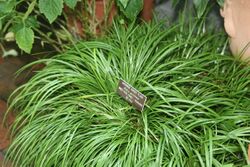Biology:Acorus gramineus
| Acorus gramineus | |
|---|---|

| |
| Scientific classification | |
| Kingdom: | Plantae |
| Clade: | Tracheophytes |
| Clade: | Angiosperms |
| Clade: | Monocots |
| Order: | Acorales |
| Family: | Acoraceae |
| Genus: | Acorus |
| Species: | A. gramineus
|
| Binomial name | |
| Acorus gramineus Sol. Aiton, 1789
| |
Acorus gramineus, commonly known as Japanese sweet flag, Japanese rush, grassy-leaved sweet flag, and grass-leaf sweet flag,[1] is a botanical species belonging to the genus Acorus, native to Japan , Korea, and eastern Asia. The plant usually grows in wetlands and shallow water.
The genome of A. gramineus has been published by independent research groups in 2022 and 2023.[2][3][4]
Description
This shrubby plant's long, narrow, slightly curved leaves may grow to 30 cm (12 inches) in height. It can grow fully or partially submerged, or in very moist soil, but it will usually only flower when at least partially submerged.[citation needed]
Var. pusillus has slightly shorter, more rigid glossy green leaves, while var. variegatus has longer leaves streaked with yellow.[citation needed]
Cultivation and uses
Acorus gramineus spreads aggressively by rhizome, creating a nearly-seamless groundcover where conditions are favorable, and it is frequently used around the edges of ponds and water gardens,[5] as well as submerged in freshwater aquaria. It can be propagated by dividing the fleshy underwater rhizome and planting the base in shallow water.[citation needed]
In Japan during the Heian period, leaves of the plant were gathered for the Sweet Flag Festival on the fifth day of the fifth month. Sweet flag and wormwood were spread on the roofs of houses for decoration and to ward off evil spirits. Special herbal balls made of sweet flag were also fashioned for the occasion.[6]
Notes
- ↑ English Names for Korean Native Plants. Pocheon: Korea National Arboretum. 2015. pp. 517. ISBN 978-89-97450-98-5. http://www.forest.go.kr/kna/special/download/English_Names_for_Korean_Native_Plants.pdf. Retrieved 25 January 2016.
- ↑ Ma, Liang; Liu, Ke-Wei; Li, Zhen; Hsiao, Yu-Yun; Qi, Yiying; Fu, Tao; Tang, Guang-Da; Zhang, Diyang et al. (2023-06-20). "Diploid and tetraploid genomes of Acorus and the evolution of monocots" (in en). Nature Communications 14 (1): 3661. doi:10.1038/s41467-023-38829-3. ISSN 2041-1723. PMID 37339946. PMC 10282084. https://www.nature.com/articles/s41467-023-38829-3.
- ↑ Guo, Xing; Wang, Fang; Fang, Dongming; Lin, Qiongqiong; Sahu, Sunil Kumar; Luo, Liuming; Li, Jiani; Chen, Yewen et al. (2023-06-20). "The genome of Acorus deciphers insights into early monocot evolution" (in en). Nature Communications 14 (1): 3662. doi:10.1038/s41467-023-38836-4. ISSN 2041-1723. PMID 37339966. PMC 10281966. https://www.nature.com/articles/s41467-023-38836-4.
- ↑ Shi, Tao; Huneau, Cécile; Zhang, Yue; Li, Yan; Chen, Jinming; Salse, Jérôme; Wang, Qingfeng. "The slow-evolving Acorus tatarinowii genome sheds light on ancestral monocot evolution" (in en). Nature Plants 8 (7): 764–777. doi:10.1038/s41477-022-01187-x. ISSN 2055-0278. PMID 35835857. PMC 9300462. https://www.nature.com/articles/s41477-022-01187-x.
- ↑ "Acorus gramineus". http://www.floridata.com/ref/A/acor_gra.cfm.
- ↑ Sei Shōnagon (2006). McKinney, Meredith. ed. The pillow book. London, England: Penguin Classics. pp. 41-42, 87-88, 282. ISBN 0140448063.
References
- Simon & Schuster's Guide to Freshwater and Marine Aquarium Fishes. New York, New York, United States: Simon & Schuster, Inc.. 1976. ISBN 0-671-22809-9. https://archive.org/details/simonschustersco00oliv.
- Sei Shōnagon (2006). The Pillow Book. London, England: Penguin Books, Ltd.. pp. 41–42, 282. ISBN 0-140-44806-3.
Wikidata ☰ Q2544575 entry
 |

